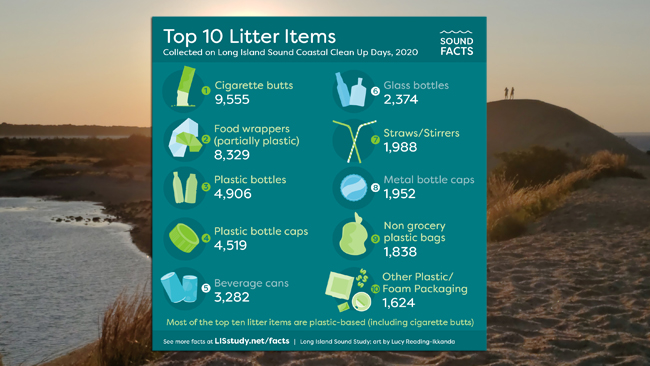
This year's campaign, run by the Connecticut and New York Sea Grant programs with support from the Long Island Sound Study, consists of cleanup events in both states, social media posts and giveaways of "Protect Our Wildlife" stickers for reusable water bottles and travel mugs. The theme, #DoOneThing, encourages people to take at least one action to reduce litter on streets, parks and beaches before it gets carried into waterways and ultimately Long Island Sound. Social media posts emphasize positive steps people are taking to address the problem.
— Filed by Stony Brook News
Stony Brook, NY, August 17, 2021 - For the fifth consecutive year of the #DontTrashLISound social media campaign — organized by New York Sea Grant (NYSG) and Connecticut Sea Grant (CTSG) with support from Long Island Sound Study (LISS); the Maritime Aquarium at Norwalk, CT; Save the Sound; and other groups — partners focus on hope for reducing plastic pollution in the estuary by highlighting positive steps people are taking to address the issue.
You can help increase the campaign’s educational impact by sharing posts to your networks starting on August 16 through International Coastal Cleanup Day on September 18.
“Plastic pollution is one of those issues that can easily feel overwhelming, but there is actually a great deal of good news to be shared,” said LISS Outreach Coordinator Jimena Perez-Viscasillas, a NYSG Cornell Cooperative Extension specialist based at Stony Brook University. “Our hope for this year’s campaign is to shed light on some of that exciting work being done here — and around the world — to encourage people to remain hopeful and proactive in their environmental stewardship.”
Messages on Facebook, Twitter and Instagram will inspire people to #DoOneThing to reduce plastic pollution in their communities. Success stories, local leaders, and marine debris prevention and cleanup efforts will shine a positive light on what is being done to combat this everyday issue. There are solutions and alternatives that Long Island communities can use to prevent the tons of plastic that enter Long Island Sound and harm our wildlife.
The campaign kicked off with a cleanup event on August 16 in Connecticut. Followers can also take advantage of other in-person events this summer.
— August 30: Beach cleanup at Hallock State Park Preserve in Riverhead, NY with NYSG, LISS and Atlantic Marine Conservation Society.
— September 18: Join any local cleanup event held on International Coastal Cleanup Day to close out the campaign celebration.
The ultimate goal of this campaign is to inspire people to clean up trash on the beaches, avoid single-use plastics and reduce the amount of plastic pollution in the Sound.
You can check out posts from the campaign using #DontTrashLISound on Twitter, Facebook and Instagram. More information on the campaign can be found at www.DontTrashLISound.net.

Bridget Cevero of the Maritime Aquarium, left, and Annalisa Paltauf of Save the Sound, hold up 35.75 pounds of trash collected by volunteers at mid-August's cleanup in CT; (Inset) #DontTrashLISound includes sticker giveaways and cleanups in NY, too. Credit: Judy Benson / Connecticut Sea Grant
More Info: Long Island Sound Study
Long Island Sound is one of the 28 nationally designated estuaries under the National Estuary Program (NEP), which was established by Congress in 1987 to improve the quality of Long Island Sound and other places where rivers meet the sea.
The Long Island Sound Study is a cooperative effort involving researchers, regulators, user groups and other concerned organizations and individuals, and is led by the Environmental Protection Agency and the states of New York and Connecticut.
In recent years, LISS has experienced a period of rapid expansion attributed to the increased federal funding for the program, and to implement actions, objectives, and goals established under a Comprehensive Conservation and Management Plan. The increase is grounded in the CCMP’s four overarching themes: Clean Waters and Healthy Watersheds, Thriving Habitats and Abundant Wildlife, Sustainable and Resilient Communities, and Sound Science and Inclusive Management. Resilience to climate change, long-term sustainability, and environmental justice, are principles that connect to all four of the themes.
For more on what you can do to make a difference, click over to the "Get Involved" or "Stewardship" sections of the Long Island Sound Study's website. News on the Long Island Sound Study can also be found in New York Sea Grant's related archives.
If you would like to receive Long Island Sound Study's newsletter, please visit their site's homepage and sign up for the "e-news/print newsletter" under the "Stay Connected" box.
More Info: New York Sea Grant
New York Sea Grant (NYSG), a cooperative program of Cornell University
and the State University of New York (SUNY), is one of 34 university-based
programs under the National Oceanic and Atmospheric Administration’s
National Sea Grant College Program.
Since 1971, NYSG has represented a statewide network of integrated
research, education and extension services promoting coastal community
economic vitality, environmental sustainability and citizen awareness
and understanding about the State’s marine and Great Lakes resources.
Through NYSG’s efforts, the combined talents of university scientists
and extension specialists help develop and transfer science-based
information to many coastal user groups—businesses and industries,
federal, state and local government decision-makers and agency managers,
educators, the media and the interested public.
The program maintains Great Lakes offices at Cornell University, SUNY
Buffalo, SUNY Oswego and the Wayne County Cooperative Extension office
in Newark. In the State's marine waters, NYSG has offices at Stony Brook
University in Long Island, Brooklyn College and Cornell Cooperative
Extension in NYC and Kingston in the Hudson Valley.
For updates on Sea Grant activities: www.nyseagrant.org has RSS, Facebook, Twitter, Instagram, and YouTube links. NYSG offers a free e-list sign up via www.nyseagrant.org/nycoastlines for its flagship publication, NY Coastlines/Currents, which is published quarterly.